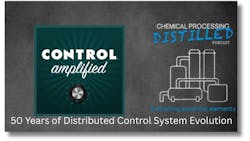ExxonMobil, Honeywell Discuss 50 Years of Distributed Control System Evolution
In a recent episode of Amplified from Control magazine (a sister publication of Chemical Processing), host Keith Larson interviews Brian Reynolds (Honeywell CTO), Alicia Kempf (Honeywell Director Offering Management), and David Patin (ExxonMobil TDC Modernization Program Lead Engineer). The discussion took place at the 2025 Honeywell User Group meeting, celebrating 50 years since the first Honeywell TDC 2000 installation in 1975.
The conversation traces the evolution of distributed control systems from centralized cabinet rooms in the 1970s-80s to today's truly distributed architecture with Universal IO and virtualization. Key developments include automated device commissioning, which reduced loop checks from hours to minutes, and the ability to modernize legacy systems on-process without shutdowns.
Looking forward, the panel discusses increasing field-level distribution via ethernet, containerized controllers, and AI tools to enhance engineering efficiency rather than replace engineers. They emphasize data-centric approaches and modularization to simplify future system upgrades. The discussion highlights the successful long-term collaboration between Honeywell and ExxonMobil in advancing industrial automation technology.
Points of Interest
02:43-03:14 - Discussion about the massive TDC Modernization Program at ExxonMobil, which will upgrade all TDC 3000 systems to Experion LCN. This sets the stage for understanding the scale of legacy system modernization in the industry.
06:19-08:53 - Discription of the three major epochs of DCS evolution: from centralized control rooms (1970s-80s), to distributed controllers in remote buildings (1990s-2015), to current Universal IO systems with field-mounted modules. This provides the historical context for how industrial control systems have truly become "distributed."
13:30-16:04 - The panel discusses the future of DCS technology, including field-level Ethernet distribution, virtualized controllers running as software containers, and AI tools to enhance engineering efficiency. This forward-looking segment outlines where the industry is heading over the next decade.
About the Author
Traci Purdum
Editor-in-Chief
Traci Purdum, an award-winning business journalist with extensive experience covering manufacturing and management issues, is a graduate of the Kent State University School of Journalism and Mass Communication, Kent, Ohio, and an alumnus of the Wharton Seminar for Business Journalists, Wharton School of Business, University of Pennsylvania, Philadelphia.

